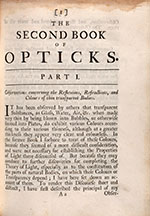LSU's first edition of Isaac Newton's Opticks
 In 1704, physicist Isaac Newton published his second major book, Opticks: or a Treatise of the Reflexions, Refractions, Inflexions and Colours of Light. Also Two Treatises of the Species and Magnitude of Curvilinear Figures. Considered one of history's great scientific works, it first defined five colors of the spectrum as red, orange, yellow, green, blue, indigo, and violet. LSU Libraries Special Collections has a first edition of the book.
In 1704, physicist Isaac Newton published his second major book, Opticks: or a Treatise of the Reflexions, Refractions, Inflexions and Colours of Light. Also Two Treatises of the Species and Magnitude of Curvilinear Figures. Considered one of history's great scientific works, it first defined five colors of the spectrum as red, orange, yellow, green, blue, indigo, and violet. LSU Libraries Special Collections has a first edition of the book.
In Opticks, Newton wrote, “My Design in this Book is not to explain the Properties of Light by Hypotheses, but to propose and prove them by Reason and Experiments : in order to which, I shall premise the following Definitions and Axioms.”
Opticks is important because it was one of the first works of science published in English and not Latin (the treatises on curvilinear figures included in Opticks, however, are in Latin). Having been published in the vernacular, Opticks could be read and appreciated by a much wider audience, an audience that existed beyond the Cambridge walls. This in turn sped the expansion of the scientific method and, in many ways, changed the way western science progressed.
This was also an era in transition from a metaphysical understanding of the Universe to what we would recognize as a scientific understanding. Newton himself was an alchemist as well as one of the founders of the new scientific method. He began to explain gravitation and how it affects planetary orbits in Principia Mathematica (published 1687). For some, he shares credit with Gottfried Wilhelm Leibniz for creating calculus (the 1704 Opticks is the first publication of the details of Newton’s work in this area). And, he proved white light to be composed of a spectrum of colors.
LSU's copy of the book has been rebound in the past, somewhat diminishing the impact of the physical object. However, it is a wonderful thing to hold and read. We do not know how many people may have owned this particular volume nor what impact it had on their lives and how that rippled through time. Although the book was originally published without Newton's name, his initials do appear at the end of the "Advertisement" page preceding the first book. We can see that someone at some time penned the author’s name on the title page. There are no other notations, doodles or other marginalia in the book.
All materials in LSU Libraries Special Collections are available to the public. We invite you to use the online catalog (www.lib.lsu.edu) to search for items of interest, place your request, and visit the reading room to hold one or more of the wonders of the world in your hands.

